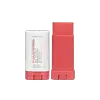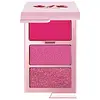What's inside
What's inside
 Key Ingredients
Key Ingredients

 Benefits
Benefits

 Concerns
Concerns

 Ingredients Side-by-side
Ingredients Side-by-side

Squalane
EmollientCaprylic/Capric Triglyceride
MaskingBis-Diglyceryl Polyacyladipate-2
EmollientOctyldodecanol
EmollientOzokerite
Emulsion StabilisingPolyisobutene
Synthetic Wax
AbrasiveMicrocrystalline Wax
Emulsion StabilisingSilica
AbrasiveCI 77891
Cosmetic ColorantSynthetic Fluorphlogopite
CI 15850
Cosmetic ColorantMica
Cosmetic ColorantCI 19140
Cosmetic ColorantGlyceryl Caprylate
EmollientCI 77492
Cosmetic ColorantEuphorbia Cerifera Wax
Tin Oxide
AbrasiveCI 45410
Cosmetic ColorantTocopheryl Acetate
AntioxidantLimnanthes Alba Seed Oil
Skin ConditioningTriethoxycaprylylsilane
Isopropyl Titanium Triisostearate
EmollientMacadamia Integrifolia Seed Oil
Skin ConditioningParfum
MaskingLinalool
PerfumingSqualane, Caprylic/Capric Triglyceride, Bis-Diglyceryl Polyacyladipate-2, Octyldodecanol, Ozokerite, Polyisobutene, Synthetic Wax, Microcrystalline Wax, Silica, CI 77891, Synthetic Fluorphlogopite, CI 15850, Mica, CI 19140, Glyceryl Caprylate, CI 77492, Euphorbia Cerifera Wax, Tin Oxide, CI 45410, Tocopheryl Acetate, Limnanthes Alba Seed Oil, Triethoxycaprylylsilane, Isopropyl Titanium Triisostearate, Macadamia Integrifolia Seed Oil, Parfum, Linalool
Cetyl Dimethicone
EmollientDicaprylyl Carbonate
EmollientCaprylic/Capric Triglyceride
MaskingSilica
AbrasiveDimethicone Crosspolymer
Emulsion StabilisingSynthetic Wax
AbrasiveSynthetic Beeswax
Emulsion StabilisingPolyhydroxystearic Acid
EmulsifyingHdi/Trimethylol Hexyllactone Crosspolymer
Methyl Methacrylate Crosspolymer
Mica
Cosmetic ColorantGlyceryl Caprylate
EmollientTocopheryl Acetate
AntioxidantGlyceryl Undecylenate
EmollientSimethicone
EmollientJasminum Grandiflorum Flower Wax
MaskingLimnanthes Alba Seed Oil
Skin ConditioningSilica Silylate
EmollientCI 77891
Cosmetic ColorantCI 77492
Cosmetic ColorantCI 45410
Cosmetic ColorantCI 15850
Cosmetic ColorantZinc Stearate
Cosmetic ColorantDimethicone
EmollientSodium Dehydroacetate
PreservativeSorbic Acid
PreservativeEthylhexyl Hydroxystearate
EmollientMagnesium Carbonate
AbsorbentOryza Sativa Hull Powder
AbrasivePropylene Glycol
HumectantHylocereus Undatus Fruit Extract
Skin ConditioningPhenoxyethanol
PreservativeCI 42090
Cosmetic ColorantCI 19140
Cosmetic ColorantTalc
AbrasiveTin Oxide
AbrasiveCI 77491
Cosmetic ColorantCetyl Dimethicone, Dicaprylyl Carbonate, Caprylic/Capric Triglyceride, Silica, Dimethicone Crosspolymer, Synthetic Wax, Synthetic Beeswax, Polyhydroxystearic Acid, Hdi/Trimethylol Hexyllactone Crosspolymer, Methyl Methacrylate Crosspolymer, Mica, Glyceryl Caprylate, Tocopheryl Acetate, Glyceryl Undecylenate, Simethicone, Jasminum Grandiflorum Flower Wax, Limnanthes Alba Seed Oil, Silica Silylate, CI 77891, CI 77492, CI 45410, CI 15850, Zinc Stearate, Dimethicone, Sodium Dehydroacetate, Sorbic Acid, Ethylhexyl Hydroxystearate, Magnesium Carbonate, Oryza Sativa Hull Powder, Propylene Glycol, Hylocereus Undatus Fruit Extract, Phenoxyethanol, CI 42090, CI 19140, Talc, Tin Oxide, CI 77491
Ingredients Explained
These ingredients are found in both products.
Ingredients higher up in an ingredient list are typically present in a larger amount.
This ingredient is an emollient, solvent, and texture enhancer. It is considered a skin-softener by helping the skin prevent moisture loss.
It helps thicken a product's formula and makes it easier to spread by dissolving clumping compounds.
Caprylic Triglyceride is made by combining glycerin with coconut oil, forming a clear liquid.
While there is an assumption Caprylic Triglyceride can clog pores due to it being derived from coconut oil, there is no research supporting this.
Learn more about Caprylic/Capric TriglycerideCi 15850 is the pigment color red. It is an azo dye and created synthetically.
Azo dyes need to be thoroughly purified before use. This allows them to be more stable and longer-lasting.
This ingredient is common in foundations, lipsticks, and blushes. This color is described as brown/orangey red.
It has many secondary names such as Red 6 and Red 7. According to a manufacturer, Red 6 usually contains aluminum.
Learn more about CI 15850CI 19140 is also known as Tartrazine. Tartrazine is a synthetic dye used in cosmetics, foods, and medicine to add a yellow color.
Tartrazine is created from petroleum and is water-soluble.
Some people may experience allergies from this dye, especially asthmatics and those with an aspirin intolerance.
Learn more about CI 19140CI 45410 is a synthetic red-pigment and dye.
It often goes by both Red 28 or Red 27; manufacturers label both ingredients as CI 45410.
This dye is commonly found in makeup because it imparts a vivid color. Some types of this dye change color based on pH level and interaction with moisture:
Your skin has a natural pH of around 4.5 - 5.5.
According to the FDA, CI 45410 is not permitted for use in eye products.
Red 27 is a flourescein dye and commonly used as a fluorescent tracer in medicine.
Learn more about CI 45410Ci 77492 is also hydrated iron III oxide. It's sole purpose is to give a yellow hue to products.
Iron III oxides are classified as inorganic chemicals for coloring.
Synthetically created Ci 77492 is considered safer than those naturally found. This is because the synthetically created version may contain less impurities. Iron oxides are generally non-toxic and non-allergenic.
Learn more about CI 77492Ci 77891 is a white pigment from Titanium dioxide. It is naturally found in minerals such as rutile and ilmenite.
It's main function is to add a white color to cosmetics. It can also be mixed with other colors to create different shades.
Ci 77891 is commonly found in sunscreens due to its ability to block UV rays.
Learn more about CI 77891Glyceryl Caprylate comes from glycerin and caprylic acid, a fatty acid from coconut. It has emollient and emulsifier properties.
As an emollient, it helps hydrate your skin. Emollients work by creating a barrier on your skin to trap moisture in, helping to keep your skin soft and smooth.
On the other hand, emulsifiers prevent ingredients (such as oil and water) from separating.
Learn more about Glyceryl CaprylateLimnanthes Alba Seed Oil is the oil extracted from the seeds of the meadowfoam plant. This oil is non-fragrant and is an emollient. As an emollient, meadowfoam seed oil helps soften and hydrate the skin.
Meadowfoam seed oil is stable and has a long shelf life due to its chemical structure. It has the highest concentration of stable fatty-acids among plant oils, preventing it from degrading once exposed to oxygen.
Due to the fatty acid content, this ingredient may not be fungal-acne safe.
Meadowfoam is native to California and Oregon.
Learn more about Limnanthes Alba Seed OilMica is a naturally occurring mineral used to add shimmer and color in cosmetics. It can also help improve the texture of a product or give it an opaque, white/silver color.
Serecite is the name for very fine but ragged grains of mica.
This ingredient is often coated with metal oxides like titanium dioxide. Trace amounts of heavy metals may be found in mica, but these metals are not harmful in our personal products.
Mica has been used since prehistoric times throughout the world. Ancient Egyptian, Indian, Greek, Roman, Aztec, and Chinese civilizations have used mica.
Learn more about MicaSilica, also known as silicon dioxide, is a naturally occurring mineral. It is used as a fine, spherical, and porous powder in cosmetics.
Though it has exfoliant properties, the function of silica varies depending on the product.
The unique structure of silica enhances the spreadability and adds smoothness, making it a great texture enhancer.
It is also used as an active carrier, emulsifier, and mattifier due to its ability to absorb excess oil.
In some products, tiny microneedles called spicules are made from silica or hydrolyzed sponge. When you rub them in, they lightly polish away dead skin layers and enhance the penetration of active ingredients.
Learn more about SilicaSynthetic Wax is created from fossil fuels such as natural gas. It is used to enhance texture, adjust pH, and as an occlusive.
It may also be used as an abrasive ingredient to exfoliate the skin.
Synthetic Wax may not be fungal acne safe.
Learn more about Synthetic WaxTin Oxide is an inorganic oxide used to add opacity and volume to a product. In nature, it is already found in mineral form. The main ore of tin is an opaque and shiny mineral called casseterite.
Tin Oxide helps remove translucency in a product, or make it more opaque. Besides adding opacity, tin oxide is used for bulking to add volume.
Tocopheryl Acetate is AKA Vitamin E. It is an antioxidant and protects your skin from free radicals. Free radicals damage the skin by breaking down collagen.
One study found using Tocopheryl Acetate with Vitamin C decreased the number of sunburned cells.
Tocopheryl Acetate is commonly found in both skincare and dietary supplements.
Learn more about Tocopheryl Acetate